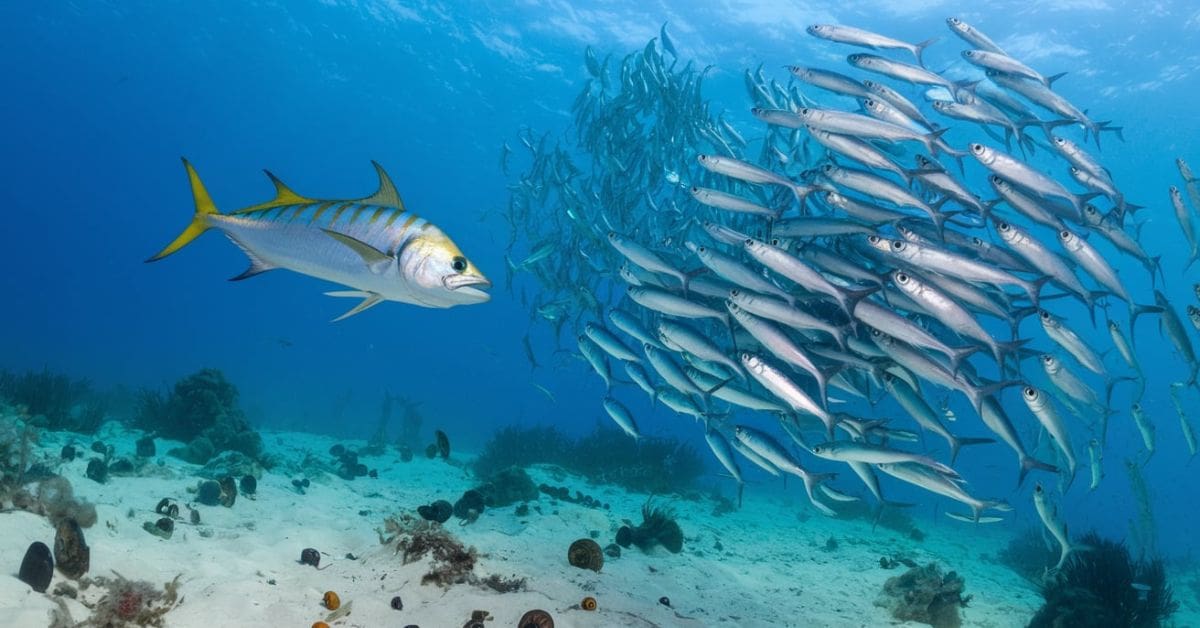The slender yellowtail kingfish, also known as Seriola lalandi, is a fast, powerful predator that inhabits temperate and tropical waters around the world. Known for their agility and speed, these fish are a thrilling sight to anyone interested in marine life. But one question often arises among enthusiasts: Do slender yellowtail kingfish eat sea snails?
In this comprehensive guide, we will go through the diet of slender yellowtail kingfish, their feeding behavior, and whether sea snails are part of their menu. By the end, you’ll have a better understanding of what these majestic fish typically eat and why sea snails don’t usually make the cut.
Understanding the Slender Yellowtail Kingfish

Before diving into the specifics of their diet, it’s important to understand the basic characteristics of slender yellowtail kingfish. These fish belong to the Carangidae family and are often found in both shallow and deep coastal waters. They are characterized by their slender bodies, bright yellow tails, and long dorsal fins. Yellowtail kingfish are predatory and are known for their ability to chase down and overpower smaller fish, which they rely on for food.
In the wild, these fish are typically solitary hunters or form schools to hunt prey more effectively. Their sharp eyesight, incredible speed, and hunting tactics make them highly efficient predators.
What Do Slender Yellowtail Kingfish Eat?
Slender yellowtail kingfish are carnivores and mainly eat animal-based foods. Their diet is composed of a wide variety of marine organisms, which are typically rich in protein and provide the energy required for their high-energy lifestyle. The primary components of a kingfish’s diet include:
Fish
- Sardines: Small, schooling fish that are abundant in coastal waters.
- Anchovies: Another small fish that schools in large numbers.
- Pilchards: Small, oily fish that offer plenty of nutrition.
- Herring: Another favored fish of the kingfish family.
- Other small pelagic fish: In some cases, yellowtail kingfish may feed on other small fish that they can overpower easily.
Squid
Yellowtail kingfish also consume squid, which is a great source of protein and fat. Squid is fast-moving and often found in the same habitats as small fish, so it’s an ideal meal for a predatory fish like the yellowtail kingfish. Squid are highly nutritious and play an important role in the diet of many marine predators.
Crustaceans
Although fish and squid make up the majority of their diet, crustaceans like shrimp, crabs, and lobsters are also eaten by yellowtail kingfish. Crustaceans provide additional sources of protein and energy. These creatures are often found near the ocean floor, and yellowtail kingfish will dive deeper to find them.
Do Slender Yellowtail Kingfish eat sea snails?

The answer is that sea snails are generally not a preferred food for these fish. Here’s why:
The Hard Shell Factor
Sea snails have hard, tough shells that are difficult to crack open. Yellowtail kingfish lack the specialized teeth that some other predators (like certain species of moray eels or larger predatory fish) possess to crush shells. Instead, the kingfish prefers fast-moving, soft-bodied animals that can be consumed quickly and with little effort.
Slow Movement of Snails
Sea snails, compared to the kingfish’s typical prey, are slow-moving creatures. Kingfish are agile hunters and are better suited to capturing fast-moving animals like fish and squid. Their feeding strategy revolves around speed and efficiency—chasing down quick, nutritious prey in open waters.
Feeding Preferences
In the wild, yellowtail kingfish tend to focus on feeding on smaller fish, squid, and crustaceans—creatures that can swim fast enough to evade capture for a short time but ultimately fall prey to the kingfish’s hunting abilities. The sluggish nature of sea snails makes them an unlikely target.
How do Yellowtail Kingfish hunt?

Speed and Agility
Yellowtail kingfish can swim at high speeds, often reaching speeds of up to 75 km/h (46 mph) in short bursts. This allows them to chase down fast-moving fish, squid, and crustaceans. They rely on their speed to overpower and capture prey, often pursuing them over long distances.
Group Hunting
Sometimes, yellowtail kingfish form schools to hunt. This collaborative approach helps them corner and capture schools of smaller fish, making it easier to catch a large number of prey at once. This strategy is very effective for maximizing their chances of a successful hunt.
Opportunistic Feeding
Yellowtail kingfish are opportunistic feeders, meaning they will take advantage of whatever food is available in their environment. If, for some reason, a snail is accessible and easy to catch (perhaps in shallow waters or after a storm), the kingfish may attempt to eat it. However, this is not their primary food source.
Role of Kingfish in the Ecosystem

- Population Control: Kingfish help regulate the populations of small schooling fish, like sardines and anchovies, preventing overpopulation and resource depletion.
- Indirect Effects: By preying on smaller fish, they can indirectly influence other species, like crustaceans or sea snails, by reducing competition or predators for these organisms.
- Indicator of Ecosystem Health: A decline in kingfish populations or changes in their diet can indicate overfishing, pollution, or other environmental issues in the ocean.
Comparison With Other Predatory Fish
| Predator | Diet | Likelihood of Eating Sea Snails | Hunting Style |
| Yellowtail Kingfish | Fish (sardines, anchovies), squid, crustaceans | Low – prefers fast-moving, soft-bodied prey | Fast chasers; active hunters |
| Tuna | Schooling fish, squid | Very low – avoids hard-shelled prey | Speed-based pursuit |
| Barracuda | Larger fish | Very low – focuses on soft-bodied fish | Ambush predator; solitary |
| Grouper | Crustaceans, mollusks, small fish | High – has powerful jaws to crush shells | Bottom-feeder; slow and patient |
Behavior of Kingfish in Captivity vs. Wild
In the Wild:
Kingfish rely on their speed and instincts to chase prey.They prefer fast-moving, soft-bodied creatures like sardines, squid, and smaller fish.Hunting requires active energy expenditure, which aligns with their natural habits.
In Captivity:
Their feeding behavior changes due to limited prey options.They are often fed pellets, small fish, or frozen squid in aquaculture or aquariums.If offered sea snails in captivity, they might eat them since they don’t need to hunt actively. This suggests that their diet adapts to availability in controlled environments.
How do Yellowtail Kingfish and Sea Snails compare?
Yellowtail kingfish and sea snails are vastly different in terms of behavior, roles, and physical characteristics. Here’s a quick comparison:
| Feature | Yellowtail Kingfish | Sea Snails |
| Diet | Carnivore – fish and squid | Herbivore – algae and detritus |
| Speed | Fast swimmer (up to 75 km/h) | Very slow-moving |
| Defense | Escapes predators with speed | Uses hard shell or mucus |
| Role | Apex predator – controls prey | Grazer – maintains algae balance |
| Size | Up to 1.8 meters (6 feet) | A few millimeters to 20 cm |
FAQs
Do slender yellowtail kingfish eat plants?
No, yellowtail kingfish are strictly carnivores and do not consume plants.
How do yellowtail kingfish hunt their prey?
Yellowtail kingfish use their speed and agility to chase down prey, often hunting in groups to herd schools of fish. They rely on their sharp eyesight to locate prey.
What types of fish do yellowtail kingfish eat?
They primarily feed on smaller fish such as sardines, anchovies, and pilchards.
Can yellowtail kingfish eat larger prey?
While they prefer smaller, faster prey, they can eat larger fish in some cases.
Do yellowtail kingfish prefer deep or shallow waters for hunting?
They are versatile and hunt in both deep and shallow waters, depending on prey availability.
Are slender yellowtail kingfish picky eaters?
They are opportunistic and will eat what is available, but they prefer fast-moving prey.
Do sea snails offer nutritional value to kingfish?
While sea snails are edible and provide nutrients, their hard shells and slow movement make them less ideal prey for active predators like yellowtail kingfish.
Final Thoughts
Slender yellowtail kingfish are skilled predators that rely on a diet consisting mainly of small fish, squid, and crustaceans. While sea snails are technically edible, they are not a part of the kingfish’s regular diet.In rare circumstances, a yellowtail kingfish may eat a sea snail if it’s an easy opportunity, but this is not common behavior.
If you’re interested in learning more about the fascinating world of yellowtail kingfish, their hunting techniques, or their role in the ocean ecosystem, keep exploring. These fish are a true marvel of nature, perfectly adapted to life in the open sea!





